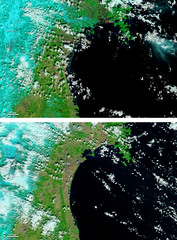In the aftermaths of the massive and devastating earthquake that hit Japan yesterday a nuclear crisis has unfolded in the country. Yesterday Japan officials declared a state of emergency at two nuclear power plants in the Fukushima Prefecture. The state of emergency at the Fukushima Daiichi (No 1) plant and at the Fukushima Daini (No 2) plant was issued after problems with the cooling systems. See our live-update from yesterday for more info.
More news on this developing story will be published here as they come.
We are taking a break from the live-updating. You can continue to follow our updates about the nuclear crisis in Japan here. For live updates about the crisis at the Fukushima nuclear power plant in Japan you can check out Al Jazeera or the Guardian.
Update 38: Meltdown may be under way at Fukushima nuclear reactor, official with Japan's nuclear safety agency tells CNN.
Update 37: AJE has this quote from a Tokyo Electric Power Co spokesman about the No.3 reactor failure:
Update 36: While the US Nuclear Regulatory Commission is sending two experts to Japan AFP reports that the operators of the Fukushima nuclear power plant, where a second reactor system is overheating, says there is a risk of a second explosion.
Update 35: The Washington Post writes that the U.N. nuclear watchdog says Japan is evacuating 170,000 people from the area near a nuclear power plant damaged in the devastating earthquake and tsunami.
Update 34:
FLASH: Japan's TEPCO says it has started preparations for releasing pressure from Fukushima Daiichi No. 3 reactor after cooling failed
Update 33: Yesterday 3 people had tested positive for high radiation levels. That number has now jumped to 160 says a Japanese nuclear safety official, AJE reports.
Update 32: The emergency cooling system of No.3 reactor has now also stopped working, the Japan Nuclear and Industrial Safety Agency has announced. Sea water is being pumped into the No.1 reactor chamber - and officials are scrambling to secure water supply to the No.3 reactor.
FLASH: Japan's nuclear safety agency says Fukushima Daiichi Nuclear Plant No. 3 reactor's emergency cooling system not functioning
Update 31:
My colleague in Tokyo reports that efforts to cool the core are failing at Fukushima nuke plant. Much remains unclear: http://j.mp/f9owtR
Update 30: Greenpeace has issued a statement regarding the radioactivity release from the Fukushima nuclear power plant in Japan:
Update 29: There is radiation leaking out, and since the possibility of exposure is high, it's quite scary said 17-year-old Masanori Ono.
Update 28: If this accident stops right now Fukushima in Japan will already be one of the three worst nuclear accidents in history, CNN reports.
Update 27: The third day since the massive earthquake and the nuclear crisis is still a big and real threat in Japan. Meanwhile about 60,000 people have formed a chain around a nuclear power station in Germany to protest its continued operation. The nuclear accident in Japan has sparked massive protests and discussions about the future of atomic power in Germany.
Update 26: The operator of the Fukushima nuclear power plant, Tokyo Electric Power Co, will fill the leaking reactor with sea water to cool it down and reduce pressure in the unit, a government spokesman says to AJE. Flooding the reactor core with sea water is the last emergency option available to try and cool down reactor fuel rods and prevent a meltdown.
Update 25: The Japanese government has now evacuated more than 300,000 people from their homes near the Fukushima Daiichi (No 1) nuclear power plant.
More than 300,000 people have now been evacuated from homes in northern #Japan due to #Fukushima Daiichi No. 1 event.
 Update 24: This is coming from our own Twitter-feed, which is another source of information regarding the nuclear situation in Japan: These NASA satellite images show the coastline before and after the tsunami in Japan. And according to German media about 60,000 people have, in response to the nuclear emergency in Japan, formed a chain around a nuclear station in Germany to protest its continued operation.
Update 24: This is coming from our own Twitter-feed, which is another source of information regarding the nuclear situation in Japan: These NASA satellite images show the coastline before and after the tsunami in Japan. And according to German media about 60,000 people have, in response to the nuclear emergency in Japan, formed a chain around a nuclear station in Germany to protest its continued operation.
Update 23: We know have some updates about those three people that have been affected by radiation: According to this Twitter post "3 patients out of 90 were tested for radiation levels. All 3 were above the normal levels. They were scrubbed. No lasting symptoms." Edit: This has now been confirmed by media. AJE writes:
Update 22:
NHK suggesting that people in the area should clean themselves thoroughly and wear long sleeves. Avoid eating food grown outdoors.
Update 21: Cabinet secretary Yukio Edano said:
AJE writes: "Edano said due to the falling level of cooling water, hydrogen was generated and that leaked to the space between the building and the container and the explosion happened when the hydrogen mixed with oxygen there."
Update 20: According to Kohei Hayashi three people have been "confirmed to be affected by radiation". Still no info about this from media. And Reuters are reporting that police patrolling near the Fukushima nuclear plant are wearing respiratory eqipment.
Update 19: Now we are getting contradicting statements from the Japanese government and TEPCO, the owners of the affected nuclear plants. TEPCO seems to be saying that there has been a meltdown but the Japanese government says that this isn't the case.
Update 18: Strong aftershock quake with a preliminary magnitude of 6 hits Fukushima:
Magnitude 6 earthquake hits Fukushima where leaking nuclear plant is based
Update 17: Independent nuclear safety analyst John Large tells Al Jazeera that, by venting the radioactive steam from the inner reactor into the outer dome, a reaction may have occurred, causing the explosion: "When I look at the size of the explosion, it is my opinion that there could be a very large leak ... the fuel continues to generate heat." John Large says that by the end of the day "we should know what the situation really is" and that: "All the jigsaw piece of the Three Mile Island disaster are being replicated at this plant - and this has gone beyond Three Mile Island."
Update 16: The deputy cabinet secretary for public relations and director of global communications at the Prime Minister's Office of Japan says there is no no damage to the nuclear reactor container following the explosion.
Blast was caused by accumulated hydrogen combined with oxygen in the space between container and outer structure. No damage to container.
Update 15: The cause and consequences of the explosion at the nuclear plant in Japan continues to be unclear. But Ian Hore-Lacy believes the explosion was due to hydrogen igniting:
Update 14: BBC News says that the operators of the Fukushima Daiichi nuclear plant are claiming that the reactor container was not damaged in the large explosion.
Update 13: AJE reports on the explosion at the Fukushima Daiichi nuclear plant and the effects of the earthquake in Japan in this video: Japan fears nuclear plant meltdown.
Update 12:
Japanese chief cabinet secretary confirms radiation leakage occured from explosion at #Fukushima nuclear power plant - Reuters
Update 11: The operator of the Fukushima Daiichi plant says the blast there happened during an aftershock to Friday's quake. AJE also reports that the Japanese government is taking security measures for an possible nuclear meltdown:
Update 10:
NHK news showing the result of explosion at Fukushima Nuclear Plant. The wall of one building gone completely. #earthquake #japan
Update 9:
Japan nuclear plant update: Area residents told to stay indoors, not drink tap water and to cover faces with wet towels or masks - Sky News
Update 8: Al Jazeera interviews Peter Hayes, the executive director of the Nautilus Institute for Security and Sustainable development in Melbourne, about the current situation and of possible scenarios in the quake-hit nuclear plants:
Update 7: BBC News shows footage of the explosion at the nuclear power plant:
Update 6: AFP and other media sources now confirms that an explosion has occurred at the TEPCO's Fukushima Daiichi nuclear plant. According to Reuters and NHK "several people appear to have been injured after the nuclear plant explosion".
Update 5: We are getting words that an explosion has taken place at the Fukushima Daiichi nuclear plant. More info shortly.
Update 4: Well this quote from AJE doesn't sound good: Peter Hayes, a nuclear expert, tells Al Jazeera "it's still possible that the reactor workers can stabilise the situation" at the Fukushima Daiichi nuclear plant "if power is brought back, if coolant is brought into the reactor", but "we're really right at the precipice of a massive nuclear crisis".
Update 3: Following the news from yesterday that fuel rod have been exposed above cooling water level at the Fukushima nuclear plant Japanese nuclear authorities now say "there is a high possibility that nuclear fuel rods at a reactor at Tokyo Electric Power Company's (TEPC) Fukushima Daiichi plant may be melting or have melted".
Update 2: I am quoting AJE directly here so that we can get back quickly to the latest news:
Update 1: Al Jazeera English reports that "scientists are warning that Japan may be facing a nuclear disaster on the scale of Chernobyl." They quote Edwin Lyman, a nuclear expert for the Global Security Programme at the Union of Concerned Scientists:








Recommended Comments
There are no comments to display.
Join the conversation
You can post now and register later. If you have an account, sign in now to post with your account.